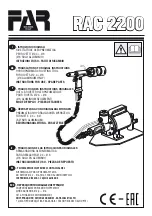
-33-
Model W1745W (For Machines Mfd. Since 9/16)
O
PE
R
ATI
O
NS
Edge Jointing
The purpose of edge-jointing is to produce a finished,
flat-edged surface (see
Figures 48–47
) that is suitable
for joinery or finishing. It is also a necessary step when
squaring rough or warped stock.
Figure 47.
Illustration of edge-jointing
results.
Figure 48.
Typical edge-jointing operation.
Removed
Surface
Portion
Removed with
Jointer
If you are not experienced with a
jointer, set depth of cut to "0", and
practice feeding workpiece across tables
as described. This procedure will better
prepare you for actual operation.
To edge joint on jointer, do these steps:
1.
Inspect stock to ensure it is safe and suitable for the
operation (see
Stock Inspection & Requirements
sec-
tion).
2.
Set infeed table height to desired cutting depth for
each pass.
IMPORTANT:
For safety reasons, cutting depth should
never exceed
1
⁄
8
" per pass.
3.
Set fence to 90˚.
4.
Start jointer.
5.
Place workpiece firmly against fence and infeed
table.
IMPORTANT:
To ensure workpiece remains stable dur-
ing cut, concave sides of workpiece must face toward
table and fence.
6.
Feed workpiece completely across cutterhead while
keeping it firmly against fence and tables during the
entire cut.
IMPORTANT:
Keep hands at least 4" away from
cutterhead during the entire cut. Instead of allow-
ing a hand to pass directly over cutterhead, lift it up
and over cutterhead, and safely reposition it on the
outfeed side to continue supporting workpiece. Use
push blocks whenever practical to further reduce risk
of accidental hand contact with cutterhead.
7.
Repeat
Step 6
until the entire edge is flat.
Tip:
When squaring up stock, cut opposite edge of
workpiece with a table saw instead of the jointer—
otherwise, both edges of workpiece will not be paral-
lel with each other.
















































